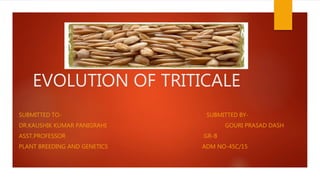
Presentation on Evolution of Triticale
- 1. EVOLUTION OF TRITICALE SUBMITTED TO- SUBMITTED BY- DR.KAUSHIK KUMAR PANIGRAHI GOURI PRASAD DASH ASST.PROFESSOR GR-B PLANT BREEDING AND GENETICS ADM NO-45C/15
- 2. Allopolyploids: A polyploid containing genetically different chromosome sets from two or more species is known as allopolyploid. The prefix ―allo indicates the involvement of non-homologous sets of chromosomes. Origin of allopolyploids: Natural allopolyploids most likely originate through chromosome doubling of F1 hybrid produced by chance through natural hybridization between two distinct species of the same genus or from different genera. Experimental production of allopolyploids is achieved through chromosome doubling of F1 hybrid with the help of colchicine. Such allopolyploids are often called synthetic allopolyploids. The synthesis of allopolyploids involves two steps. 1. Production of F1 hybrids by crossing two distinct species and 2. Chromosome doubling of such F 1 hybrids. The man made cereal Triticale is an example of synthetic allopolyploid.
- 3. Natural allopolyploids: Inter-specific crossing followed by chromosome doubling in nature have resulted in origin of some natural allopolyploid crops like cotton, tobacco, mustard, wheat, etc. Artificial allopolyploids: Artificial allopolyploids have been synthesized in some crops either to study the origin of naturally available allopolyploids or to explore the possibilities of creating new species.The evolution of triticale is an example of artificial allopolyploids.
- 4. TRITICALE Botanical Name: Triticale hexaploide Lart. Chromosome No: Octoploids: 2n = 8x =56[Triticum aestivum (2n=-6x=42) x Secale cereale (2n=2x=14)] Hexaploids: 2n = 6x = 42 Triticum durum (2n=-4x=28) x Secale cereale (2n=2x=14) Genomic constitution: Octaploid (8x) AABBDDRRR. Hexaploid (6x) = AABBRR
- 5. INTRODUCTION- Triticale, the first successful human-made cereal grain, was deliberately produced in 1875 by crossing wheat with rye. The term triticale was coined by combining generic names of wheat (Triticum) and rye (Secale). Almost 3 million ha of triticale are grown today in the world. Present information available at the International Maize and Wheat Improvement Center (CIMMYT) shows that since the mid-1970s more than 200 cultivars have been released in more than 30 countries. Triticale can certainly play a significant role in alleviating poverty for many needy families in some developing countries.
- 6. Rimpau (1890) in Germany successfully attempted a cross between wheat and rye. The hybrids resulting from such crosses were sterile. The initial triticales developed were octaploids and have the problems of reduced seed set due to partial sterility. With the successful artificial culturing of embryos (12-15 days old) on nutrient media in late 1940’s, the hexaploids came into existence. In India, Jawaharlal Nehru Krishi Vishwa Vidyalaya (JNKVV), Indore has extensive triticale improvement programme.
- 7. Contribution of some scientists in evolution of Triticale- The first report describing the production of hybrid plants between wheat and rye was presented to the Botanical Society of Edinburgh,Scotland, by the botanist Wilson in 1875. succeeded in obtaining plants with attributes intermediate between those of the two species.Both plants were completely sterile as they produced completely disfunctional pollen grains. In the 30 August 1884 Carman published the first-ever illustration of a partially fertile wheat-rye hybrid plant. In 1890, the German breeder Rimpau (reported inRimpau, 1891) performed a series of betweenwheat and rye, which resulted in a unique, partially fertile true-hybrid plant 15 seeds. Three of these producedcompletely sterile plants, while the remaining 12 yieldedfertile plants. Unlike the progenies of Carman’s hybrid, those from Rimpau’s hybrids were uniform in their appearance, resembled the mother F1 plant.
- 8. Some triticales are hexaploids and are developed from a cross between tetraploid wheat (Triticum turgidum ) and rye.
- 9. Octaploid triticales are produced from a cross between hexaploid wheat (Triticum aestivum) and rye.
- 10. Utility Triticale grain is mainly utilized for animal feeding in North America. The bread making properties of triticale were inferior to wheat owing to high ash content, low flour yields upon milling. It forms an important forage crop for livestock feeding. At present, majority of triticale grown in US livestock feeding only. Triticale is suitable for making chapaties and these chapaties were similar to wheat in quality. It forms an important forage crop for livestock feeding. Triticales are rich in protein (10-20%), and lysine (0.57%) than wheat. The culms are thick, hence resistant to lodging. They are also more frost hardy than wheat and thus are suitable for cultivation at higher altitudes.
- 11. Varieties The first commercial cultivar of triticale came from Europe. ‘Rosner’ was the first triticale cultivar of North America developed in Canada, where as ‘Siskiyou’ is the first triticale cultivar released in USA. The majority of triticale cultivars have prominent awns. The development of awnless triticales (awn<5 mm length) in recent times has increased its use as fodder crop. In India till date only four cultivars are released of which two are by Central Varieties Release Committee and two by State Varieties Release Committee. Triticale (70-2) It is a late maturing variety having brownish white, bold and hard grains. It is susceptible to lodging at high levels of fertility. It is suitable for bread and biscuit making.
- 12. Triticale DTS-703 This is a one gene dwarf (110 cm) strain maturing in 135 days with moderate resistance to rusts. It is medium in tillering with a test weight of 36 g. It is less susceptible to lodging. Triticale DTS-551 It is a medium tall (110-120 cm) strain resistant to rusts, and matures in 140 days. Grains are bold with a test weight of 50 g. It is susceptible to lodging at high fertility and has non-synchronous flowering. DT 46 Recommended for northern hills zone. Other varieties/ cultures tested: Other varieties / introductions tested in India in early seventies include ST-69-1, Armadillo PPV- 13, Amphidiploid-1, Triticale arm, PM-312,T4, and PC-202.
- 14. THANK YOU…….
